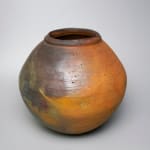Kawabuchi Naoki 川淵直樹
H24.1 x W22.8 x D25.4 x Lip Dia11.9 cm
Further images
-
(View a larger image of thumbnail 1
)

-
(View a larger image of thumbnail 2
)

-
(View a larger image of thumbnail 3
)

-
(View a larger image of thumbnail 4
)

-
(View a larger image of thumbnail 5
)

-
(View a larger image of thumbnail 6
)

-
(View a larger image of thumbnail 7
)

-
(View a larger image of thumbnail 8
)

-
(View a larger image of thumbnail 9
)

-
(View a larger image of thumbnail 10
)

-
(View a larger image of thumbnail 11
)

-
(View a larger image of thumbnail 12
)

-
(View a larger image of thumbnail 13
)

The category of “Nanban” directly translated as “Southern Barbarians from the South”—the Portuguese and Spanish traders who came to Japan in the 16th and 17th centuries– refers to a history of trade between Europe and Japan. Kawabuchi Naoki practices a technical and visual genre of Modern yakishime pottery that recalls this globalized history. Modern Nanban jars such as this jar produced in the 1990s echo the types of export stoneware the Nanban traders would purchase. Though one might traditionally picture porcelain as the main export ceramic from Japan to Europe, stoneware, like this vessel, was exceedingly popular too. In this jar, Kawabuchi uses ash and stone to articulate the textures of gold foiling, ink, silk, and lacquerware as seen on the screen paintings that imagined Nanban landscapes.
Kawabuchi graduated from Wakao university before training in ceramics in the Nara prefecture, specializing in techniques of producing Akahada wares. As well as Nanban yakishime jars, he also practices Kohiki glazes in his functional wares.












